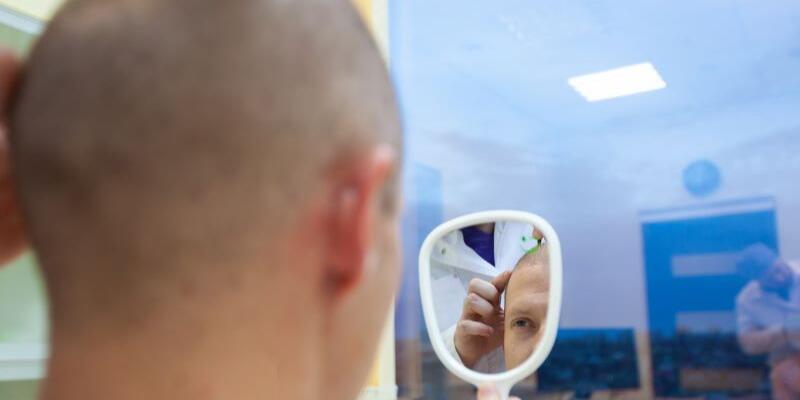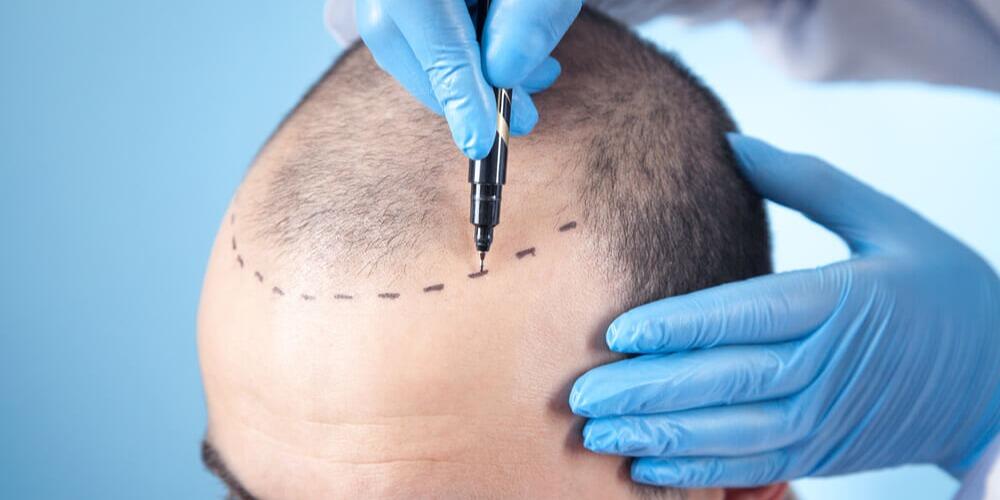Patchy Beard Guide: Causes, Styles & Solutions
- Why Is My Beard Patchy? Understanding the Causes
- How to Fix a Patchy Beard and Support Even Growth
- Patchy Beard Styles – Which One Suits You?
- How to Fill in a Patchy Beard: Techniques for a Fuller Appearance
- How Does a Beard Transplant Work?
- Understand the Science behind Patchy Beard Growth and Take It from There
In This Guide
Explore the oft-asked, ‘why is my beard patchy?’, and understand the causes.
Learn how to fix a patchy beard and ensure even growth.
Learn about the various patchy beard styles that would suit you.
Discover how to fill in a patchy beard for a fuller look.
Dive deep into the science behind patchy beard growth.
A beard can be an expressive feature of a man's appearance, signalling style, maturity and distinction, which is why a patchy beard can be a real hindrance to men who want to define themselves with consistent, full growth. If you've ever wondered, ‘why is my beard patchy?’, you're not alone. Many men struggle with facial hair that grows unevenly. Fortunately, a patchy beard doesn't have to be a permanent plight. With the right understanding and approach, you can work with what you’ve got to achieve more style, or even a fuller-looking beard. This guide will walk you through everything you need to know.
Why Is My Beard Patchy? Understanding the Causes
Beard growth begins during puberty, filling in thicker from cheek to cheek as the formative years go by, though ending sometimes with a patchy beard to varying extents. There are various reasons this can happen:
Genetics can be responsible for patchy beard growth, just as they are for other inherited traits.
An imbalance of hormones can play a role too, since thick beard hair is dependent on the hormone dihydrotestosterone (DHT). Many people experience an imbalance of hormones in general, and DHT can be one of them, which may cause patchy beard growth. Visit your doctor to see what can be done about this.
Lifestyle factors should also be borne in mind if you have a patchy beard, because good hair growth requires certain nutrients, making a healthy diet that incorporates vitamins and minerals crucial. Cutting out alcohol and smoking is also known to have a good effect on growth, and stress is another factor that can hinder it.
Skin conditions can also cause patchy beard growth, where an infection or inflammation can leave a hairless gap. Visit your doctor if this is the case, as these conditions can be treated, which may then help your beard come through fuller.
How to Fix a Patchy Beard and Support Even Growth
There are some measures you can take if you’d like to try adding some growth to your patchy beard. These tips are tried and tested methods to offer support to growth. Just bear in mind that everyone will respond differently to them, and in some cases, these actions may not offer a complete change to your situation or even materialise the desired effects at all. It is nevertheless worth considering them if you're wondering how to fill in patchy beard growth:
Patience is key: often, the patches may fill out on their own with time. Giving your beard the chance to grow might be all you need.
Proper nutrition: ensure you're on a balanced diet that is rich in vitamins and minerals known to promote hair growth, like biotin, vitamin E, and zinc.
Regular care: using beard oils and moisturisers can support healthy skin and hair follicles, encouraging consistent growth.
Patchy Beard Styles – Which One Suits You?

The best thing to do with your beard is to embrace the uniqueness of its growth pattern by adopting a style that fits it. Even regardless of whether someone has a full beard or not, many shave and groom theirs in a way that shapes it into an individual look. Some popular patchy beard styles include:
The stubble look: a classic, rugged appearance that works well with uneven growth.
Goatee: if the cheeks are patchier, focusing on the chin area with a goatee can be a stylish option.
Chin strap: likewise, you can follow the jawline up to the sideburns with whatever thickness suits you.
Moustache: as one of the first parts of a man’s facial hair to come through, growing out your moustache is often a good option if the surrounding area is patchy.
Strategic shaping: with the help of a barber, shape your beard in a way that highlights the fuller areas and minimises the appearance of patches.
How to Fill in a Patchy Beard: Techniques for a Fuller Appearance
You may have tried things like nutrition and using care products but may have some gaps you’d like to fill, in which case there are some further steps to consider. These are more intensive but do offer more apparent change in a lot of cases:
Beard dyes: darkening your beard can often make it appear fuller than it is.
Makeup: believe it or not, products like eyebrow pencils can be used to fill in patchy areas subtly.
Beard transplants: for a more permanent solution, it is possible to transplant hair follicles into the affected areas. Beard transplants are becoming an increasingly popular way to alter a patchy beard.
How Does a Beard Transplant Work?
A plastic surgeon will perform a beard transplant using the same devices and methods as hair transplantation on the scalp, which these days entails a highly innovative way of taking individual follicles from a ‘donor area’ (a dense area like the back of the head) and placing them precisely into affected areas. Many men have found beard transplantation to be a permanent solution not only in cases of patchy beard growth, but also where little to no beard would come through naturally at all.
As with any cosmetic procedure, each person is going to have their own desires and requirements, which will determine what is surgically possible and the method that will be used. The procedure has come a long way, so the options are usually either follicular unit extraction (FUE) or follicular unit transplantation (FUT). Both techniques entail making small incisions that individual hair grafts are placed into, making it a very accurate process.
After the procedure, it's not uncommon to experience minor redness or swelling in the initial few weeks. Adhering to post-operative care is crucial for best results and to avert complications. The full healing process takes around one year, after which the fullness of results will be visible. The transplanted hairs will first undergo a shedding phase, but within a few months, these follicles begin to rejuvenate, growing new hair and effectively filling in the patchy beard areas. For more detail on the process, take a look at our guide to beard transplant surgery.
Understand the Science behind Patchy Beard Growth and Take It from There
Hair growth is a complex process influenced by various factors like genetics, hormones, and overall health; the patchy beard growth many men experience is often due to a combination of these elements. Understanding the science behind it can be beneficial in adopting the right strategies to promote even beard growth that works best for you. There is plenty to try out and experiment with, but above all it’s important to remember that there is no ‘wrong’ style and you should always embrace your unique characteristics.
With the right approach, knowledge and care, you can flaunt your facial hair with confidence; a patchy beard can absolutely be worked into your style. However, if you are still looking for ways to attain more fullness with a transplant, Qunomedical has you covered. With a choice of vetted professionals, we’ll easily find you a trusted surgeon whose expertise and affordability will grant you an exceptional treatment experience. Reach out to us and we’ll get you started!
Sources:
Dr. Mario Garcia & Dr. Miriam Garces: ISHRS: 'Beard and Mustache Transplant', last accessed 24.08.23
Braun: 'What Are the Reasons Behind a Patchy Beard?', last accessed 24.08.23
Adam Cheung (2023): 'How to Fix a Patchy Beard', last accessed 24.08.23
Related Tags
Recent Stories
- Discover the 10 best countries for a hair transplant in 2023, plus information on popular clinics and doctors worldwide. read more...
What Does a Good Hair Transplant Look Like?
Hair loss can have a big impact on people's confidence and self-esteem, which is why getting a good hair transplant is something that more people are turning towards. With impressive advancements that have brought the field significantly forward in the past years, hair transplantation is accessible to a wider, gloabal audience. read more...Where to Get the Best Hair Transplant in Turkey
Everyone wants the best outcome for their procedure, so it’s only natural to want to find the place that will perform the best hair transplant. In Turkey there are plenty of first-class clinics to choose from, but it’s important to remember that such a choice must be one that suits the right surgeon to your individual needs. read more...

Patient manager
Frieda
Your personal Patient Manager
Let's talk
Still unsure? Feeling overwhelmed? Talking to a real person can give you the guidance and reassurance needed. You don’t have to do it alone. Let’s find the right doctor together.





